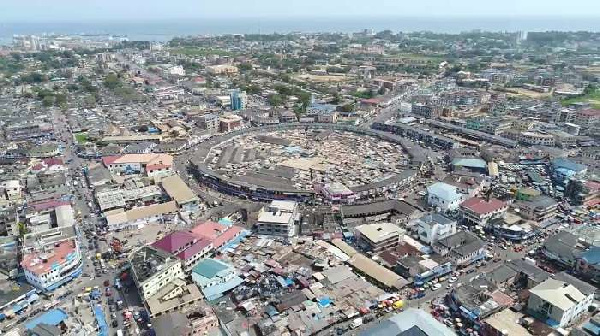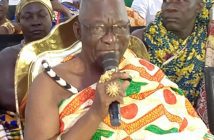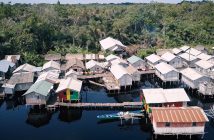After a walk through the city of oil in Ghana, their economy, schools, tourist attractions and other, we will be looking at the various towns in Takoradi and what they are characterized by.
Princes Town or Pokesu is located 5 km east of Fort St. Antonio on Manfro Hill in the Ahanta West District of the Western Region of south Ghana. It lies between Axim to the west and Sekondi-Takoradi to the east. On 1 January 1681, a Brandenburger expedition of two ships commanded by Otto Friedrich von der Groeben, arrived in the Gold Coast, and began to build a strong fort between Axim and the Cape of Three Points. The fort was completed in 1683 and was renamed Fort Fredericksburg (German: Gross-Friedrichsburg) in honour of Prince Frederick William I, Elector of Brandenburg. Because the fort was named after a Prince, it has been referred to as Princes Town. The fort was to be the headquarters of the Brandenburgers in Africa.
In 1708, an Akan merchant, John Canoe learned that the Germans were going to sell the fort to the Dutch. In protest, he began a resistance that managed to stave off fleets of battleships for almost 20 years. The fort was eventually captured in 1725 by the Dutch and renamed “Hollandia”. Because John Canoe was successful in retaining control of the fort, inhabitants looked upon him as a hero. In 1872, the Dutch ceded the fort to Britain and in 1957, the fort became part of the newly independent country of Ghana.
“Junkanoo” (pronounced “John Canoe”) festivals such as Mardi Gras are held annually in the coastal outlines of North Carolina, in Jamaica and the Bahamas.
Fort Fredericksburg
The Fort Fredericksburg was built of stone transported by sea between 1681 and 1683 from Prussia and is one of two German forts built in Ghana, the other being Fort Dorothea. It is estimated that some 300,000 Africans were transported through this fort. The remains of John Canoe are a mystery. Some have said he was captured after having lost the battle of the fort while others say his remains are in the Tafo Cemetery in Kumasi.
Tarkwa is a town and is the capital of Tarkwa-Nsuaem Municipal district, a district in the Western Region southwest of South Ghana. Tarkwa has a 2013 settlement population of 34,941 people
Tarkwa is noted as a center of gold mining and manganese mining. Tarkwa Mine, which is a large open-cast gold mine, is situated to the northwest of the town, and Nsuta manganese mine is situated to the east of the town.
A number of mining companies cluster between the villages of Aboso and Tamso in the late 19th century.
Tarkwa Mine has the distinction of being one of the largest gold mines in South Ghana. Approximately 24 tons of gold is produced annually, and 100 million tons of earth is moved to achieve this production rate. The Iduapriem Gold Mine is also located near Tarkwa, 10 km south of the town. The Tarkwa Goldfield was discovered a few years before the Witwatersrand Goldfield in South Africa.
Wright, J.B.; Hastings, D.A.; Jones, W.B.; Williams, H.R. (1985). Wright, J.B. (ed.). Geology and Mineral Resources of West Africa. London: George Allen & UNWIN. pp. 45–47
Prestea is a town in the Western Region, in southwest Ghana and about 50 km north of the coast of the Atlantic Ocean. It lies on the west bank of the Ankobra River, about 60 mi (100 km) northwest of Cape coast. The town is part of the Prestea-Huni Valley District.[2] Prestea is the forty-sixth most populous in Ghana, in terms of population, with a population of 35,760 people. A railway line used to connects with Prestea to Tarkwa and beyond to the coastal city of Sekondi-Takoradi.
History of Prestea
Since 1873 there has been mining of gold deposits in Prestea, and in 1965, independent gold mining companies based in Prestea were merged at the time by the government. The World Bank granted a loan in 1985 to finance the gold mining in Prestea, but after three years of continuous losses by the merged gold company, the mines that were privatized from 1994 to 1999 had their mineral rights sold to the Canadian company of Golden Star Resources. The mining of gold caused environmental problems, such as the storage of overburden in the vicinity of the hospital, contamination of the river with toxic waste, as happened in October 2004. Due to the vibrations caused by the explosions, damage was caused to the buildings of the town. The gold mines are a tourist attraction, partly due to the smelter where the gold is melted down into ingots and two tennis courts and an 18-hole golf course.
Economy
The Prestea community has suffered from the detrimental effects of over a century of mining activities, as of 2011 this town still boast of only one senior high school in the area although overwhelming amount of riches is being gained from their soils.
Education
The higher education institution is the Prestea Senior High Technical School. There is also the Prestea Goldfields International School. Due to the presence of gold in abundance in Prestea, the kids don’t like pursuing education but rather they like to chase money by indulging in small scale mining practices.
Sports
In the years 2002 and 2003, the town’s local football club Prestea Mines Stars played in the highest Ghanaian football league, the Ghana Premier League. The renovated Prestea stadium was financially supported by the company Bogoso Gold Limited. In 2019, the Prestea community was blessed with the establishment of a modern recreational park by Golden Star Bogoso/Prestea Limited. The recreational park has facilities like Female and Male Locker Rooms, Lecture Hall, Two Basketball Courts and Spacious Car Park as well as vast utility area. Since its commissioning, the facility has become a center for social gathering. Political parties host their Presidential Aspirants, Annual NBA Nights, Wedding Reception and Musical Festivals.
Stay connected to us for part two of the towns in Takoradi the capital town of the Western Region of Ghana and their unique heritage.
SOURCES
ghanawestcoast.com
web.archive.org
tarkwansuaem
anglogold.com
Wright, J.B.; Hastings, D.A.; Jones, W.B.; Williams, H.R. (1985). Wright, J.B. (ed.). Geology and Mineral Resources of West Africa. London: George Allen & UNWIN. pp. 45–47. ISBN 9780045560011.





